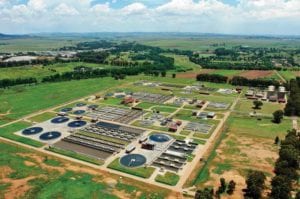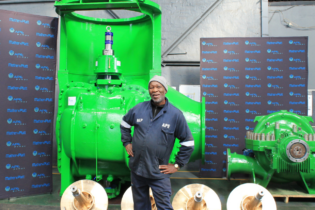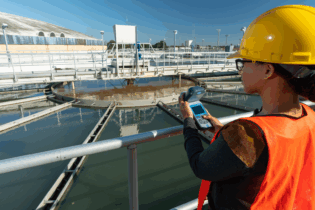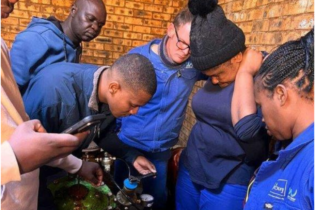ERWAT’s construction of the large-scale sludge handling facility at the Waterval Wastewater Care Works has reached the final stages, according to Koos Wilken, ERWAT’s executive manager: Development, and project manager Sipho Mateza.
The construction of the sludge handling facility at the Waterval Wastewater Care Works near Klip River, Gauteng, is being undertaken in two phases, namely the civils phase and then the mechanical, electrical and instrumentation phase. The facility was a follow-on project from the 50 Mℓ/d Module 4 expansion that ERWAT commissioned in 2008. “As a result of the extension of Module 4, we have a significant increase in the amount of sludge that we need to stabilise and dewater. We therefore had to build a dewatering facility that would dewater sludge for Module 4, as well as the other modules,” says Mateza. The existing plant consists of a modern preliminary treatment facility, four parallel liquid biological treatment modules and tertiary disinfection before the final effluent is discharged into the Klip River, with the total design capacity of the Waterval Wastewater Care Works now equalling 155 Mℓ/d. Once completed, the sludge handling facility will not only be able to process approximately 55 dry tonnes of sludge per day from the works, but will also significantly bolster ERWAT’s capacity to deliver in the region, which has been witness to a lot of urban development and expansion within the catchment. “This is our regional works for that catchment area, so it is of critical importance because it serves large areas like Katlehong, Thokoza, Germiston, Alberton and parts of Vosloorus,” says Wilken. Sustainable approach to sludgeTraditionally, the sludge generated from the Waterval Wastewater Care Works, the biggest wastewater care works operated by ERWAT, underwent digestion and then solar drying before being distributed to the local agricultural community. “The approach we currently have is to stabilise the sludge, in line with the sludge guidelines and the requirements of the environmental impact assessment that was done. What is special is the fact that once you stabilise sludge you create a lot of alternate opportunities because it is then safe for other use,” says Wilken. Once the mechanical, electrical and instrumentation phase of the project is completed, the digesters will then be operational. “From that outcome, the possibility of the generation of gas becomes a reality. Although we are not doing anything immediately with the gas, apart from preheating the sludge before digestion, during the next phase we will be looking at the possible utilisation of the gas, perhaps to generate heat, which could be used to create electricity,” he explains. The primary result of entering the operational phase is compliance with the immediate requirements of the environmental impact assessment and the sludge guidelines. “However, I think it sets the scene to look at more beneficial utilisation of the sludge, viewing it more as a valuable product rather than a waste product and environmentally it will be a much more acceptable solution,” states Wilken. He adds that the second part of the present process, which is drying the sludge, again creates opportunities for sustainable practice. “Once you have removed the bulk of the water it is easier to transport the dehydrated sludge to different sites to make different products – agricultural use, for example. It also creates the opportunity to further process the sludge. As part of the next phase we will also be looking at the possibility of pelletising the sludge and enriching it,” he continues. Construction dynamics
The first phase of the project, which consisted of the civils portion, started on 15 October 2009 and was completed on 18 November 2011. The first phase contract was initially estimated to be worth R50.8 million, but came in well under budget, says Mateza, adding that the savings amounted to approximately R9.6 million. The contractor on this project was Eigenbau.
The final M.E.I installation phase began on 12 March 2012 and, as Mateza indicates, the team is still very busy on-site with the anticipated completion date being 10 October 2013. Skills transfer on-site is a major focus, although greater skills transfer was achievable on the construction of Module 4. “On the sludge specific portion of the project, however, this was more specialised and required more specialised skills, which inhibited the use of local labour and skills transfer. However, there are local staff that are employed for both projects – the civils and the mechanical and electrical portions of the project – with the local labour on-site totalling 29 workers.”
“The highlight of this project for me is that although we had a number of difficulties, such as the procurement of the mechanical and electrical instrumentation contractor because of a change in management and project managers, we were still able to navigate these challenges and deliver,” continues Mateza. The primary challenges on-site, according to Mateza, have been delays, which resulted in the anticipated completion date being changed from 1 April to 10 October this year, but the team is intent on completing the project as soon as possible. This is very much in line with ERWAT’s strategic focus, adds Wilken, which is to supply the right-sized works in the best geographical location at the most economical cost, incorporating the finest and most appropriate available technology. Wilken adds that it is not easy to roll out large-scale projects as finances and sourcing the appropriate skills is becoming more challenging. However, according to Wilken, in general the challenges are primarily related to project management. “It is more important that you get a good project manager on-site who can ensure the project is completed on time and within budget, with a constant focus on good record keeping. A good project manager will ensure that the necessary resources are available when needed, the necessary reporting has been done, the necessary risk evaluation has been done and they tend to those risks, with the risk assessment being a living document that they constantly take into account.” He is quick to add that these challenges are not a deterrent to ensuring the success of the project. “We need to embrace the challenges and find ways to get it done in budget and on time.” Uniquely qualified“If you look at the end product, the layout plan, it is neat and something we can be proud of. Built into that is a lot of experience and technology,” says Wilken, adding that ERWAT utilises consultants on large-scale projects such as this one in addition to its own experience and expertise gained from previous projects. “In our development of the project, we work very closely with operations and maintenance, and I think that is a big advantage in ERWAT. Our approach is really to work so closely with operations that when we hand the project over there are no hiccups or tension – there is only close cooperation and a sense of satisfaction. ” In addition, Wilken believes finding a balance between new technologies and older tried and tested technologies ensures that the works function efficiently from the start. This means that every project – as with every module on this specific project – is approached on an individual basis. “Every time we apply our minds, evaluate what worked in the past and what we are comfortable with, but also look at the other areas that are important to the company on a strategic basis, such as energy efficiency. There is constant renewal and careful moving forward.” Planning for the future
Despite the expansion, Waterval Wastewater Care Works is soon going to reach capacity, according to Wilken and Mateza. While the works is designed to treat 155 Mℓ/d, Mateza adds that during heavy rainfalls the works is receiving “a little bit more than that”, which the ERWAT team must still treat to conform to the Department of Water Affairs’ standards. “We are doing that successfully, but it is essential that we extend the plant further, as well as the sewer conveyors or pipelines. This is a huge investment that needs to be taken into consideration,” says Mateza. “I think as far as the future is concerned, we will need a further extension quite soon. We are also getting some flow from the Midvaal area, some of which is industrial flow, which also impacts the operation at Waterval. Strategically for us, it is a very important plant and we will start planning for the new extension soon,” concludes Wilken.








